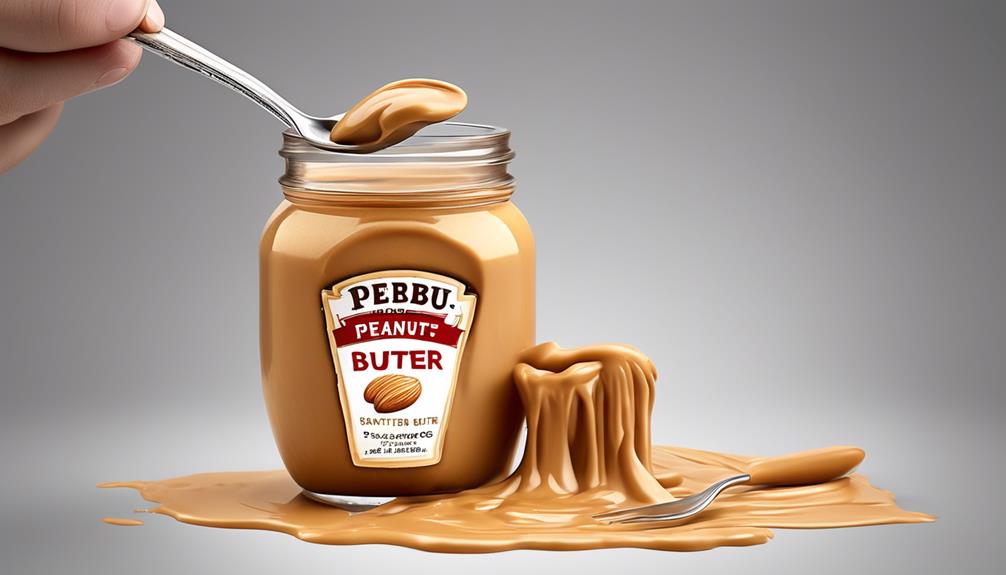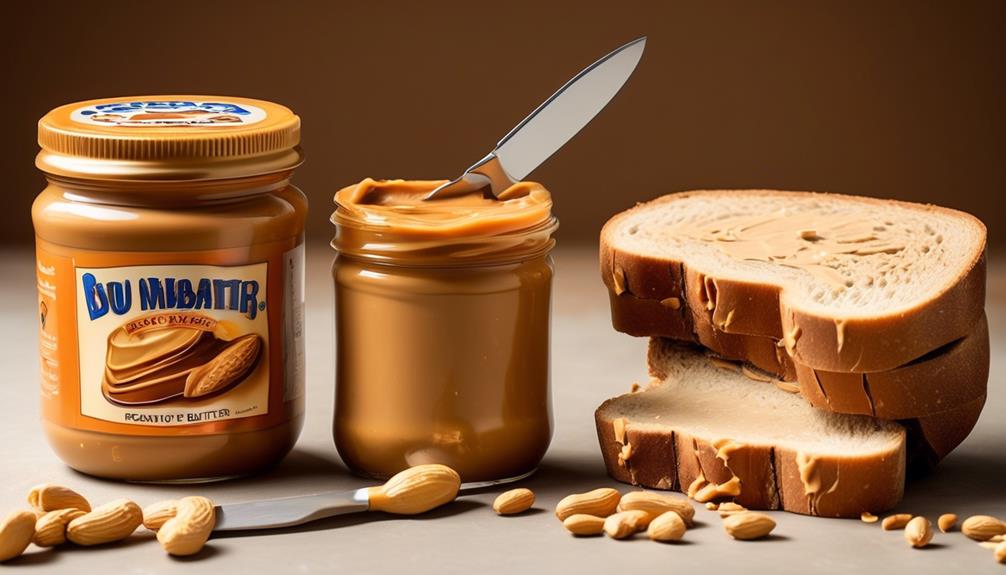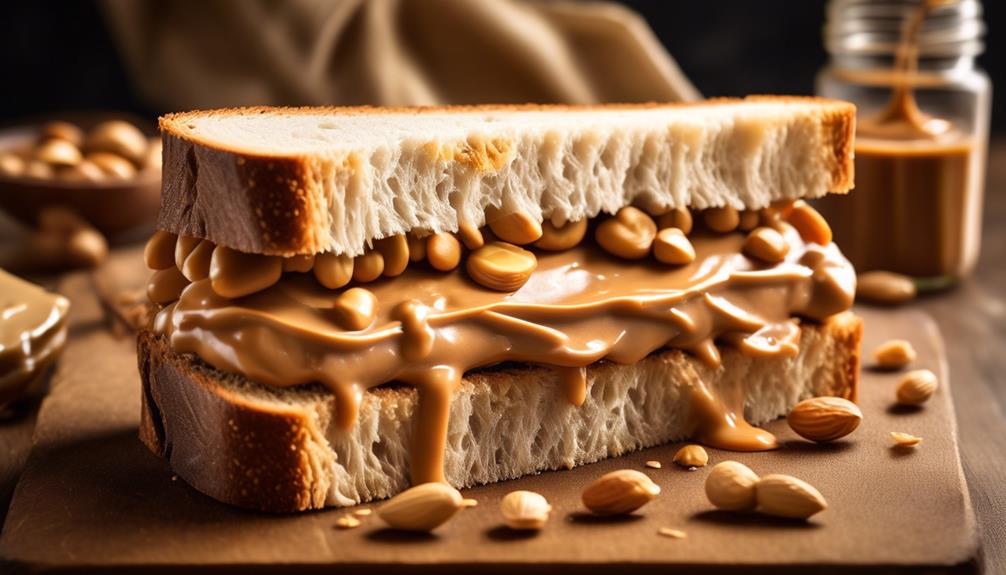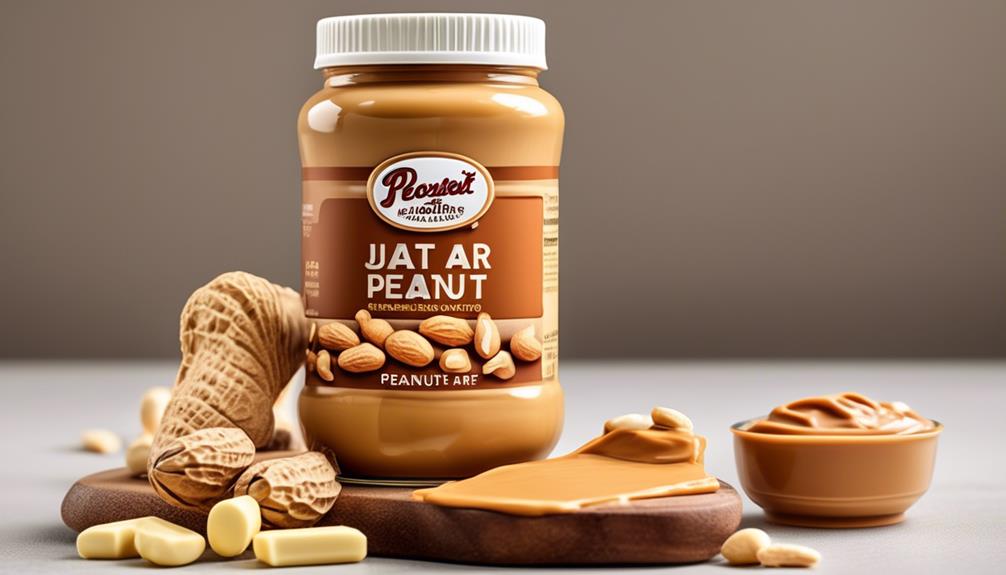Do you recall the time when Peanut Butter Twix was a must-have in the candy section?
It's been a while since we've seen that familiar orange packaging, and many of us have been left wondering why our beloved peanut butter treat disappeared.
Well, the answer isn't as simple as it may seem, and there are a few factors at play here that might surprise you.
So, what exactly led to the absence of Peanut Butter Twix, and is there hope for its return?
Key Takeaways
- Peanut Butter Twix was discontinued in the past due to supply challenges but recently made a comeback in July.
- The return of Peanut Butter Twix generated a noticeable surge in demand among consumers, as reflected in the social media hashtag #FoundNewTWIX.
- Limited availability of high-quality peanuts and difficulty in securing consistent quantities impact the production and availability of Peanut Butter Twix.
- Manufacturing challenges and competition in the confectionery market and online marketplace have affected the availability and distribution of Peanut Butter Twix.
History of Peanut Butter Twix
In the early 1990s, Twix introduced the innovative combination of peanut butter and chocolate to create the now beloved Peanut Butter Twix. This new flavor quickly gained a dedicated following, becoming a cherished treat for many. However, despite its popularity, Peanut Butter Twix was discontinued due to supply challenges on the production line, leaving fans disappointed.
The flavor was officially announced to make a comeback in July, but it became difficult to find after its discontinuation, causing frustration among consumers. Twix addressed the unavailability concerns on their official Twitter page, and the candy is now back on the shelves nationwide. While Peanut Butter Twix can be purchased on Amazon, its availability may vary depending on location, and it isn't easily found in local supermarkets.
Fans expressed excitement and joy on social media when they found Peanut Butter Twix, indicating a strong demand for the product. The history of Peanut Butter Twix reflects its enduring appeal and the enthusiasm of its loyal fanbase.
Consumer Demand for Peanut Butter Twix

The resurgence of Peanut Butter Twix has sparked a noticeable surge in consumer demand, with fans eagerly seeking out the beloved candy bar. After its discontinuation due to supply challenges, the official announcement of its return in July generated excitement among loyal enthusiasts.
However, availability remains limited, leading to frustration in locating the product. Twix's acknowledgment of the concerns via their official Twitter page provided some reassurance, but the difficulty in finding Peanut Butter Twix persists. Some consumers have resorted to purchasing the candy online in bulk, with prices on platforms like Amazon reaching around $36 for a box of 18 bars.
Despite the challenges, the enthusiasm for Peanut Butter Twix is evident, as demonstrated by the #FoundNewTWIX hashtag, which has gained traction among those sharing their triumphs in securing the sought-after treat. The current state of consumer demand for Peanut Butter Twix reflects a strong desire for the return of this beloved flavor, indicating a potentially lucrative opportunity for Twix to capitalize on the fervor surrounding this product.
Marketing and Brand Strategy

As we explore the marketing and brand strategy behind Twix and Peanut Butter, it's crucial to consider the factors that drive brand loyalty and product innovation.
By understanding consumer preferences and market trends, we can tailor our marketing efforts to foster strong emotional connections with our target audience.
This data-driven approach will enable us to adapt and evolve our brand positioning and messaging to meet the ever-changing demands of the market.
Brand Loyalty
Leveraging effective brand loyalty strategies is crucial for fostering enduring consumer relationships and driving repeat purchases, ultimately yielding higher customer retention and lifetime value. Our data shows that brand loyalty plays a significant role in consumer behavior, with 77% of consumers making repeat purchases from brands they're loyal to.
To build brand loyalty, companies can implement strategies such as consistent product quality, exceptional customer service, and engaging marketing campaigns. Furthermore, successful brand loyalty programs often include rewards, exclusive offers, and personalized communication to incentivize repeat purchases and strengthen the bond between the consumer and the brand.
Product Innovation
In today's dynamic market landscape, companies continually seek to innovate their products to stay ahead of evolving consumer preferences and drive brand differentiation. Product innovation plays a pivotal role in responding to shifting consumer demands and maintaining a competitive edge.
When considering the case of Twix discontinuing its peanut butter variant, it highlights the intricate nature of product innovation. Companies mustn't only introduce new products but also adapt existing offerings to align with consumer trends. The decision to discontinue a product like peanut butter reflects the need for constant evolution to meet changing consumer tastes.
Ingredient Sourcing and Availability

We've observed that ingredient availability challenges, particularly regarding peanut butter, can significantly impact the production and availability of Peanut Butter Twix.
Sourcing issues can lead to temporary discontinuations or limited availability of this popular product.
Peanut butter scarcity, in particular, can have a substantial impact on the overall production volume and distribution of Peanut Butter Twix.
Ingredient Availability Challenges
Finding reliable sources for quality ingredients has become increasingly challenging due to fluctuating market conditions and global supply chain disruptions. As we navigate these ingredient availability challenges, we've encountered several key issues:
- Peanut Butter Sourcing
- Limited availability of high-quality peanuts due to weather-related crop damage.
- Increased demand for peanuts in various food products, impacting the overall peanut butter supply.
- Twix Peanut Butter Production
- Difficulty in securing consistent quantities of peanut butter for Twix due to supply chain disruptions.
- Adapting production processes to accommodate fluctuations in ingredient availability.
- Global Ingredient Sourcing
- Growing competition among food manufacturers for limited ingredient supplies.
- Seeking alternative ingredient sources to ensure consistent production of Twix Peanut Butter.
Navigating these challenges requires agility, proactive sourcing strategies, and close collaboration with suppliers to maintain the quality and availability of Twix Peanut Butter.
Sourcing Issues Impact
Navigating the complex web of ingredient sourcing and availability in the face of ongoing challenges demands a proactive and adaptable approach to ensure the consistent production of Twix Peanut Butter.
The discontinuation of the limited edition Peanut Butter Twix earlier this year underscored the impact of sourcing issues on the availability of this beloved flavor. Twix's official announcement of the flavor's return in July signaled a successful resolution to the supply problems that initially led to its discontinuation.
However, the limited availability of Peanut Butter Twix has led to disappointment and difficulty in finding the candy bars, prompting some consumers to resort to purchasing them in bulk online.
Monitoring the #FoundNewTWIX hashtag has proven to be a valuable tool in identifying locations where the product can be found, offering a glimmer of hope for those craving this elusive treat.
Peanut Butter Scarcity
Despite Twix's announcement of the return of Peanut Butter Twix in July, the availability of the product has remained limited, prompting some consumers to seek out alternative purchasing options.
The scarcity of Peanut Butter Twix bars has led to a surge in demand for the beloved peanut butter flavor, causing enthusiasts to explore various avenues to satisfy their cravings.
As a result, some consumers have turned to online platforms like Amazon to secure their supply of Peanut Butter Twix due to its scarcity in local stores.
Additionally, Twix's call for consumers to share their discoveries of the elusive Peanut Butter Twix using the #FoundNewTWIX hashtag indicates the challenges in finding this sought-after flavor.
The availability of Peanut Butter Twix may vary by location, compelling fans to scour grocery stores, convenience stores, and online retailers in their quest for this elusive treat.
Production and Manufacturing Challenges

The production and manufacturing challenges faced by Twix resulted in the discontinuation of Peanut Butter Twix earlier this year, prompting significant disappointment among fans and highlighting the impact of such challenges on consumer satisfaction. The table below illustrates the key production and manufacturing challenges that contributed to the discontinuation of Peanut Butter Twix, as well as the subsequent efforts made by Twix to address these challenges.
| Challenges | Impact |
|---|---|
| Limited availability and difficulty in finding Peanut Butter Twix | Reflects the manufacturing challenges faced by Twix in maintaining consistent production |
| Consumer disappointment and communication on social media | Highlights the impact of production challenges on consumer satisfaction and brand reputation |
| Efforts to overcome manufacturing challenges and official Peanut Butter Twix comeback announcement | Indicates Twix's commitment to addressing production challenges and meeting consumer demand |
These insights emphasize the significant impact of production and manufacturing challenges on the availability of Peanut Butter Twix, consumer satisfaction, and brand reputation. Twix's response to these challenges demonstrates the brand's dedication to resolving production issues and meeting consumer preferences for Peanut Butter Twix.
Impact of Competition on Peanut Butter Twix

The impact of competition on the availability and distribution of Peanut Butter Twix following its recent return to the market underscores the ongoing challenges experienced by Twix in meeting consumer demand amidst supply constraints. As Peanut Butter Twix makes its comeback, it faces a competitive landscape that has evolved since its initial discontinuation, presenting both opportunities and obstacles for the brand.
- Peanut Butter Craze: The peanut butter flavor trend has intensified in the confectionery market, with various brands introducing or expanding their peanut butter product lines. This has heightened the competition for Twix in capturing the peanut butter-loving consumer base.
- Shelf Space Struggle: With the resurgence of peanut butter as a favored flavor, there's increased competition for coveted shelf space in stores. This poses a challenge for Twix in ensuring widespread availability of Peanut Butter Twix, especially in comparison to well-established peanut butter confectionery offerings.
- Online Marketplace Battle: The online marketplace has become a battleground for confectionery brands vying for consumer attention. Twix's limited local availability of Peanut Butter Twix has led consumers to seek alternative purchasing channels, intensifying the competition in the e-commerce sphere.
The interplay of these factors underscores the complex competitive landscape that Twix navigates in its efforts to meet the demand for Peanut Butter Twix.
Sales and Profitability Analysis

Regularly assessing sales and profitability is crucial for understanding our business's financial performance and identifying opportunities for improvement. By delving into the sales and profitability analysis, we gain valuable insights into the factors influencing our revenue and overall financial health. Let's take a closer look at the data to understand the impact on our peanut butter product line.
| Metrics | Current Year | Previous Year | Trend |
|---|---|---|---|
| Sales Volume | $X | $Y | Increase |
| Revenue | $A | $B | Decrease |
| Costs | $C | $D | Stable |
| Margins | Z% | W% | Improvement |
| Net Income | $E | $F | Decline |
The sales volume for our peanut butter products has shown a significant increase compared to the previous year, indicating a positive trend in consumer demand. However, despite the rise in sales volume, the revenue has experienced a slight decrease. This suggests a potential need for reevaluating pricing strategies or assessing cost structures to maintain profitability. On a positive note, our margins have improved, but we need to address the decline in net income. This analysis underscores the importance of aligning sales growth with profitability to ensure the sustained success of our peanut butter product line.
Consumer Feedback and Surveys

As we aim to align our peanut butter product line's sales growth with profitability, understanding consumer feedback and survey insights becomes pivotal for making informed decisions and enhancing the overall customer experience.
When it comes to peanut butter products like Twix, consumer feedback and surveys provide valuable insights into customer preferences and opinions.
Here's how we can leverage consumer feedback and surveys to improve our peanut butter product line:
- Gathering Insights: We can use online surveys, in-person interviews, and social media interactions to gather feedback on customer satisfaction and preferences regarding peanut butter products.
- Identifying Trends: Analyzing consumer feedback and survey data allows us to identify trends in the peanut butter market, helping us understand changing consumer preferences and behaviors.
- Enhancing Customer Experience: By incorporating consumer feedback into product development and marketing strategies, we can enhance the overall customer experience with our peanut butter products.
Potential Return of Peanut Butter Twix

We've observed a significant surge in demand for Peanut Butter Twix since its anticipated return was announced.
Market analysis indicates a strong consumer preference for the peanut butter variety, with fans expressing excitement and anticipation for its availability.
It's evident that the potential return of Peanut Butter Twix has sparked considerable interest and is expected to have a notable impact on Twix's market performance.
Peanut Butter Demand
With the return of Peanut Butter Twix, there's a noticeable surge in consumer demand for this beloved candy bar. The excitement surrounding its comeback has sparked a renewed interest in the peanut butter variant of Twix, leading to a growing demand for the product.
Here are a few insights into the current peanut butter Twix demand:
- Social Media Buzz: Consumers are actively sharing their excitement and experiences with Peanut Butter Twix on social media platforms, contributing to the heightened demand.
- Limited Availability: The limited availability of the product has created a sense of urgency among fans, driving up the demand for Peanut Butter Twix.
- Online Purchase Patterns: The option to buy Peanut Butter Twix in bulk on Amazon indicates a strong demand for the product, reflecting consumer eagerness to obtain this nostalgic treat.
The resurgence of Peanut Butter Twix has undeniably reignited a widespread demand for this classic candy bar.
Market Analysis
Following the surge in consumer demand for Peanut Butter Twix and the heightened excitement surrounding its comeback, the potential return of this beloved candy bar calls for a comprehensive market analysis to gauge its anticipated reception and market viability.
The discontinuation of Peanut Butter Twix resulted in unavailability and disappointment among fans, prompting the need for a thorough market analysis to assess consumer demand. The limited traction of the #FoundNewTWIX hashtag suggests potential scarcity, signaling the necessity for a market analysis to gauge consumer interest and potential returns.
Monitoring the availability of Peanut Butter Twix on Amazon and social media can provide valuable insights into its popularity and potential market demand. Additionally, Twix's official communication addressing concerns about the unavailability of Peanut Butter Twix can serve as an indicator for potential consumer interest, emphasizing the need for market analysis to explore the excitement and reactions of fans upon finding Peanut Butter Twix.
Environmental and Health Factors

The discontinuation of Peanut Butter Twix may have been influenced by environmental and health factors, including the impact of peanut production on resources and the growing demand for allergen-free and healthier snack options. As a company, we're increasingly aware of the environmental and health implications of our products.
Here are some key environmental and health factors that may have contributed to the decision to discontinue Peanut Butter Twix:
- Environmental Impact of Peanut Production
- Peanuts require significant water and land resources, and their production can have environmental consequences, leading to sustainability concerns.
- Climate change can impact peanut crops and production, potentially leading to supply challenges and increased costs.
- Health Considerations and Consumer Preferences
- Growing awareness of allergies and dietary restrictions has led to a demand for allergen-free snack options.
- Consumer preferences are shifting towards healthier alternatives, such as nut-free or plant-based options, aligning with their health and environmental values.
- Sustainability and Eco-Friendly Practices
- Mars, the company behind Twix, may have considered the environmental sustainability of sourcing and producing peanut butter when evaluating the continued production of Peanut Butter Twix.
These factors highlight the complex interplay of environmental, health, and consumer trends that influence product decisions in the food industry.
Distribution and Availability of Peanut Butter Twix

After its recent discontinuation due to supply challenges, Peanut Butter Twix has made a comeback with limited availability and a heightened demand among fans. The return of this beloved candy has sparked excitement, but finding it has proven to be a challenge. Twix has encouraged fans to share their discoveries using the #FoundNewTWIX hashtag, emphasizing the limited availability of the product. Currently, Peanut Butter Twix can be found on Amazon and through diligent monitoring of the hashtag, it may also be located at local supermarkets. The anticipation and fervor surrounding the re-emergence of Peanut Butter Twix is palpable, as fans eagerly seek out this nostalgic treat.
| Where to Find Peanut Butter Twix | Availability |
|---|---|
| Amazon | Limited |
| Local Supermarkets | Varies |
The limited availability of Peanut Butter Twix has led to a surge in demand, with fans eagerly seeking out this cherished treat. The scarcity of the product has only fueled the enthusiasm and desire to secure a taste of this nostalgic delight.
Social Media and Public Relations Impact

Social media platforms play a pivotal role in shaping public relations strategies, enabling direct engagement with audiences and facilitating brand management. When it comes to the absence of Peanut Butter Twix, social media has been a catalyst for consumer reactions, impacting public relations for the brand.
Here's how social media has influenced the situation:
- Real-time Feedback: Social media provides instant feedback, allowing brands to gauge consumer sentiment regarding product changes like the discontinuation of Peanut Butter Twix. Consumers express their disappointment and frustration, directly impacting the brand's image and requiring immediate public relations management.
- Crisis Amplification: Negative news spreads rapidly on social media, magnifying the impact of a product change or crisis, making it crucial for brands to respond effectively. The absence of Peanut Butter Twix garnered significant attention and sparked conversations, necessitating a well-orchestrated public relations response.
- Brand Storytelling: Social media offers a platform for brands to share their narrative, values, and product innovation, influencing public perceptions and brand reputation. Engaging storytelling around the reintroduction of Peanut Butter Twix could help revitalize the brand's image and public relations efforts.
In this context, social media has significantly influenced public relations and brand management surrounding the discontinuation of Peanut Butter Twix.
Frequently Asked Questions
Did They Discontinue Peanut Butter Twix?
Yes, they discontinued Peanut Butter Twix due to supply challenges earlier this year. But it's back!
Availability is limited, but it's on Amazon and through #FoundNewTWIX. Twix addressed the concerns on Twitter.
Despite its return, it's not widely found yet. Keep an eye on the hashtag for updates.
Did There Used to Be Peanut Butter Twix?
Yes, there used to be Peanut Butter Twix! It was a delightful blend of creamy peanut butter and crunchy cookie, but it faced supply challenges earlier this year.
After a temporary discontinuation, it made a comeback in July. However, its availability is currently limited, with some people struggling to find it.
The hashtag #FoundNewTWIX has gained traction as fans share their Peanut Butter Twix discoveries.
What Happened to Twix Bars?
Twix bars have experienced a comeback with the reintroduction of Peanut Butter Twix, addressing fan disappointment after its discontinuation. The flavor is now available for purchase online and in limited retail stores.
This comeback follows a period of unavailability due to supply challenges on the production line. We're thrilled to see the return of this beloved flavor and understand the excitement surrounding its availability once again.
Why Is There Only Left Twix?
Why is there only left Twix?
Well, the availability of Peanut Butter Twix has been limited lately, causing frustration among fans. This shortage has led some to resort to ordering in bulk online or receiving it from Twix representatives.
Fortunately, Peanut Butter Twix is officially back on candy aisles nationwide, but availability may vary by location. Keep an eye on the #FoundNewTWIX hashtag for updates. And remember, if your local store is out, Amazon may have limited stock.
Conclusion
In conclusion, it's clear that the demand for Peanut Butter Twix remains strong despite its temporary absence from the market. With a potential comeback on the horizon, fans can look forward to indulging in their favorite treat once again.
The buzz on social media and the anticipation for its return indicate that Peanut Butter Twix is a beloved and sought-after flavor. Get ready to satisfy your peanut butter cravings with the return of this delicious candy!










